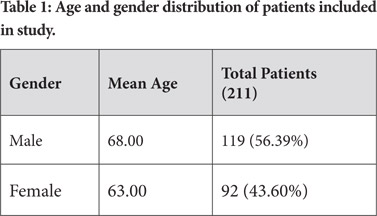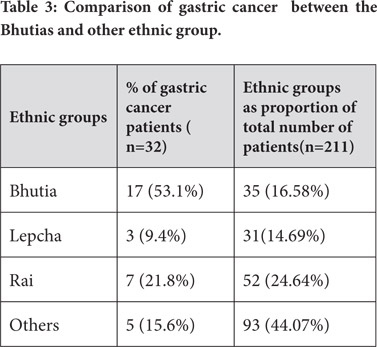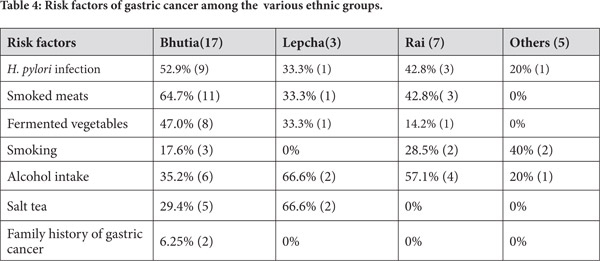Sangey Chhophel Lamtha1, Manish Kumar Tripathi2, Karma Doma Bhutia3, Caroline Karthak4
1Central Referral Hospital, Sikkim Manipal,
2Sikkim Manipal Institute of Medical Sciences 5th Mile, Sikkim, Banaras Hindu University Varanasi, Uttar Pradesh,
3Department of Microbiology, Sir Thutop Namgyal Memorial Hospital, Sikkim,
4Central Referral Hospital, Institute of Medical Sciences, 5th Mile, Gangtok
Corresponding Author:
Dr. Sangey Chhopel Lamtha
Gastroenterology Department, Central Referral Hospital, Sikkim Manipal Institute of Medical Sciences 5th Mile, Tadong, Gangtok Sikkim, Pin737101
email: sangey79@yahoo.com
DOI:
http://dx.doi.org/10.7869/tg.318
Abstract
Introduction: The etiology of gastric cancer is multifactorial. Marked differences in the incidence of gastric cancer among different ethnic groups living in the same geographical area have been observed.
Aim and methods: This study looked at ethnic and dietary factors in patients with gastric cancer diagnosed at a tertiary referral centre in Sikkim over a period of one year. Patients of 60 years and above were included in the study and divided into four ethnic groups : Bhutias, Lepchas, Rais and other groups.
Results: 211 cases underwent upper GI endoscopy and 32 were diagnosed to have gastric cancer. Gastric cancer incidence was highest in Bhutia ethnic group. A trend towards higher intake of smoked meats, fermented vegetables, salt tea, and H.pylori positivity in the Bhutia ethnic group was associated with higher incidence of gastric cancer as compared to other ethnic groups.
Conclusion: The study with a referral centre bias showed that Bhutia ethnic group had a higher incidence of gastric cancer as compared to other ethnic groups.
|
48uep6bbphidcol2|ID 48uep6bbphidvals|1699 48uep6bbph|2000F98CTab_Articles|Fulltext An ethnic group is a social group of people who identify with each other based on common ancestral, social, cultural, or national experience[1].There are four major ethno – racial groups in India - the Caucasoids, the Australoids, the Mongoloids and the Negritos[2]. However, there exists significant overlap between the populations because of racial admixture. In Sikkim, there are 13 ethnic groups having diverse lifestyle and dietary habits. The 13 ethnic groups as defined by Directorate of Economics, Statistics, Monitoring and Evaluation (DESME) (State Socioeconomic census, 2006) were aggregated into the following 3 main groups due to small numbers of cases: Bhutia, Rai and others (including all 11 other ethnic groups).
The Lepcha was the earliest ethnic group in Sikkim. They believe they are the autochthones while others believe them to be thirteenth century settlers who migrated from the Assam hills before the arrival of the Bhutias[3]. The Bhutias themselves are immigrants from the Tibetan province of Khams[4]. The dominant heterogeneous population, including the Rais, are later immigrants from Nepal.[5]
In this prospective study, we analysed the hospital data of gastric cancer among these ethnic groups , so as to highlight the need for population specific intervention.
Materials and method
This study is a prospective study conducted in the Department of Gastroenterology, Central Referral Hospital, Sikkim Manipal Institute of Medical Sciences, Sikkim in the time period Jan 2014 - Jan 2015. During this time, a total of 243 patients of 60 years and above presented to the Gastroenterology Department as OPD patients. Out of these, 32 patients were cases of chronic liver disease and were excluded. The remaining 211 patients were enrolled in the study . Detailed history regarding food habits, alcohol consumption and smoking, and relevant family history was taken. All patients underwent upper gastrointestinal endoscopy and biopsy was taken from any abnormal lesions of the stomach. This was sent for histopathological examination in to the department of pathology . Helicobacter pylori test was done with rapid urease kit. Pink color was taken as positive for H.pylori presence.
Results
The study included 211 patients with male to female ratio of 1.29:1 (Table 1) and ages ranging from 60 to 90 years old . The distribution according to ethnicity was: 35 Bhutias, 31 Lepchas, 52 Rais and 93 others . On upper gastrointestinal endoscopy, 32 were diagnosed to have gastric cancer. Out of the remaining 179, 39 showed no abnormal findings on endoscopy, 43 showed signs of antral gastritis, 6 of duodenitis, 16 of gatroesophageal reflux, 28 had gastric ulcers and 47 had duodenal ulcers (Table 2). Out of the 32 gastric cancer patients, 17 were Bhutias, 3 Lepchas, 7 were Rais and 5 others (Table 3).There was significant difference between the presence of gastric cancer between Bhutias and rest ethnic groups (p<0.05) as shown in Table no 3.
Out of the 32 cancer patients in this study, 2 (6.25%) patients had a positive family history (both were Bhutias). H.pylori was positive in 52.9%, 33.3%, 42.8%, 20% of the cancer patients of the Bhutia, Lepcha, Rai and other ethnic groups respectively.


 Dietary details
History of intake of salted, fermented vegetables and smoked meat in diet was present in 8 (47.0%) and 11(64.7.%) of Bhutia patients respectively (Table 4). There was an average consumption of approximately 200 gms of smoked meat (beef and pork) once a week for an average of 20 years among 11 Bhutia,1 Lepcha,3 Rai patients. History of alcohol consumption was present in 35.2%, 66.6%, 57.1%, 20.0% cases in Bhutia, Lepcha, Rais and other ethnic groups respectively.
Dietary details
History of intake of salted, fermented vegetables and smoked meat in diet was present in 8 (47.0%) and 11(64.7.%) of Bhutia patients respectively (Table 4). There was an average consumption of approximately 200 gms of smoked meat (beef and pork) once a week for an average of 20 years among 11 Bhutia,1 Lepcha,3 Rai patients. History of alcohol consumption was present in 35.2%, 66.6%, 57.1%, 20.0% cases in Bhutia, Lepcha, Rais and other ethnic groups respectively.
 Discussion
The etiology of gastric cancer is multifactorial. Marked differences in the incidence of gastric cancer among different ethnic groups living in the same geographical area have been observed.This may reflect the role of a host of genetic and socio-environmental factors peculiar to a particular ethnic group[6]. Role of environmental factors, including dietary habits, have been implicated in past literature. Consumption of salted, smoked, pickled and preserved foods rich in salt, nitrite and N-nitro compounds is associated with an increased risk of gastric cancer[7]. Smoking and alcohol consumption have been proposed as risk factors for gastric cancer in some epidemiological studies, but their role has been inconsistent[8]. Similarly, dietary factors have been studied in some epidemiological studies from India, but their role has not been consistently proven[8]. H.pylori is a very important risk factor for gastric cancer. Our study showed high intake of smoked meats, fermented vegetables, salt tea, positive family history and H.pylori positivity in the Bhutia ethnic group was associated with increased incidence of gastric cancer.
Although case-control studies have not identified alcohol intake as an independent risk factor for gastric cancer in India[9], some researchers believe that alcohol may increase stomach cancer risk by inducing alterations in gastric juice acidity, and due to contamination with carcinogenic substances like N-nitrosodimethylamine[10]. Smoking has been found to be a variable risk factor for gastric cancer, as reported by studies in India[9]. Our study identified smoking as a risk factor for gastric cancer.
Conclusion
Our study found significant variation in the hospital burden of gastric cancers in the ethnic mongoloid groups of Sikkim. The highest number of cases were found to be in the Bhutia ethnic group. Further studies should be to find out the role of genetic and environmental risk factors, and their contributions in development of disease in the population.
References
Discussion
The etiology of gastric cancer is multifactorial. Marked differences in the incidence of gastric cancer among different ethnic groups living in the same geographical area have been observed.This may reflect the role of a host of genetic and socio-environmental factors peculiar to a particular ethnic group[6]. Role of environmental factors, including dietary habits, have been implicated in past literature. Consumption of salted, smoked, pickled and preserved foods rich in salt, nitrite and N-nitro compounds is associated with an increased risk of gastric cancer[7]. Smoking and alcohol consumption have been proposed as risk factors for gastric cancer in some epidemiological studies, but their role has been inconsistent[8]. Similarly, dietary factors have been studied in some epidemiological studies from India, but their role has not been consistently proven[8]. H.pylori is a very important risk factor for gastric cancer. Our study showed high intake of smoked meats, fermented vegetables, salt tea, positive family history and H.pylori positivity in the Bhutia ethnic group was associated with increased incidence of gastric cancer.
Although case-control studies have not identified alcohol intake as an independent risk factor for gastric cancer in India[9], some researchers believe that alcohol may increase stomach cancer risk by inducing alterations in gastric juice acidity, and due to contamination with carcinogenic substances like N-nitrosodimethylamine[10]. Smoking has been found to be a variable risk factor for gastric cancer, as reported by studies in India[9]. Our study identified smoking as a risk factor for gastric cancer.
Conclusion
Our study found significant variation in the hospital burden of gastric cancers in the ethnic mongoloid groups of Sikkim. The highest number of cases were found to be in the Bhutia ethnic group. Further studies should be to find out the role of genetic and environmental risk factors, and their contributions in development of disease in the population.
References
- Peoples J. and Bailey G. Humanity : An Introduction to Cultural Anthropology, 9th ed, Wadsworth Cengage learning;2010. 389.
- Consolidated report of population based cancer registries of India, 2009-2011, ICMR: NCDIR, Bangalore, (2013).
- Goshi HG. “Chapter 3: History of Sikkim: A Himalayan Kingdom”. Sikkim: Past and Present. Mittal Publications;2004. p60. ISBN 81-7099-932-4.
- Risley HH. The Gazetteer of Sikkim. Delhi; Low Price Publications.1928.p 5–38.
- Menon NRM, Banerjea, D, West Bengal National University of Juridical Sciences. Sikkim; Allied Publishers; 2005.pp 5–13.
- Miller BA, Kolonel LN, Bernstein L, et al. eds. Racial/ Ethnic Patterns of Cancer in the United States, 1988– 1992.
- Lee JK, Park BJ, Yoo KY, Ahn YO. Dietary factors and stomach cancer: a case-control study in Korea. Int J Epidemiol 1995; 24:33-41.
- Rao DN, Ganesh B, Dinshaw KA, Mohandas KM. A case-control study of stomach cancer in Mumbai, India. Int J Cancer 2002; 99:727-31.
- Gajalakshmi CK, Shanta V. Lifestyle and risk of stomach cancer: a hospital-based case-control study. Int J Epidemiol 1996; 25:1146-53.
- Prasad MP, Krishnaswamy K. N-nitrosamines in Indian beers. Indian J Med Res 1994; 100:299-301.
|